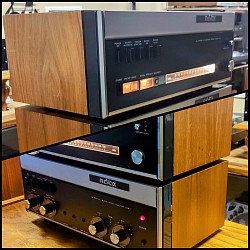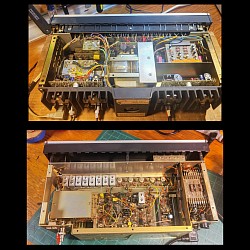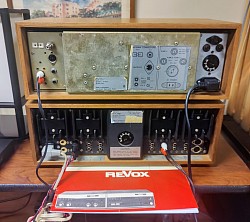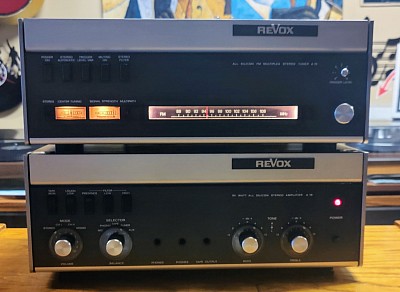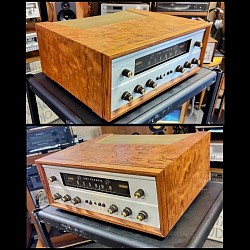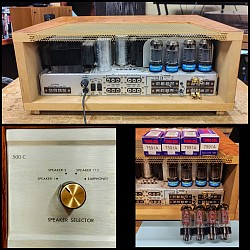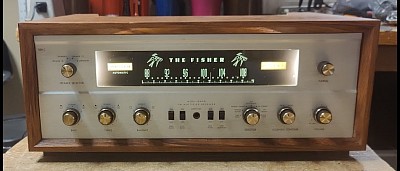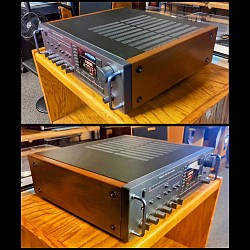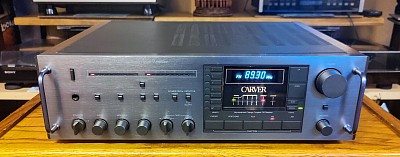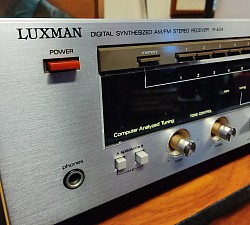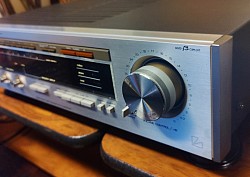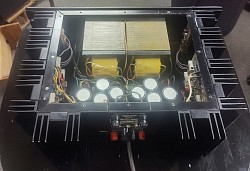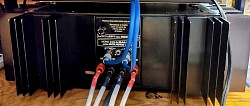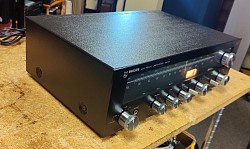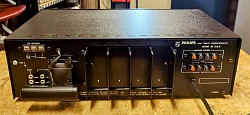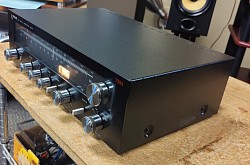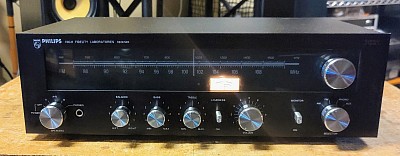Page 1 Vintage Stereo Receivers ~ Tuners ~ Amps ~ Preamps
Revox A-78 / MK1 & A-76
integrated amp (Switzerland '71-'77) 50 WPC / stereo tuner (Switzerland ('69 - '71)
$600/ set only
Obtained locally, both of these fine vintage Revox units have been completely disassembled as per our usual intensive servicing procedures. We would say that these two units are definitely at the level of quality that suggest they should be part of any fine collection of vintage HiFi components.
Both units have been thoroughly tested and found to be in excellent mechanical condition.
Essentially, both units are in very good cosmetic condition and fully operational. The lovely genuine teak cabinets are simply beautiful. All the unique European style knobs and switches are also in excellent condition.
NOTE: As a bonus, we will include a free pair of ADS L300 speakers, they are small but excellent monitors rated at 4 ohms, perfect for the Revox amp as remotes. Also included is another A-76 tuner for parts.
Because they require proprietary cables for speaker and tape connection, we are including all the wires and cables necessary for optimum use. The original operating manuals are included as well.
The Revox A-78 integrated amp was a much improved version of the previously respected A-50 model. The changes were almost invisible when taking into account the simple and timeless cosmetic design which, to most folks, are reminiscent of typical Danish-style fine furniture. It was mainly concerning the electronics inside the unit. As a result, the transmission properties of the A-78 accommodate all important factors, such as: excellent linearity, low distortion and a very good signal-to-noise ratio.
The A-76 stereo tuner is a very good quality Revox unit produced towards the end of the 60's and beginning of the '70s. The tuner is characterized by a very clearly organized interior and (at the time) very modern solutions concerning the use of new circuits. Reception and listening tests carried out after the A-76 had been launched showed it met the highest requirements, and thus has been included in an elite group of the best VHF receivers in the world. Even today, almost 50 years later, the tuner sounds amazing (with the proper antenna).
The teak enclosures have been lightly sanded and stained.
New lamps have been installed in the front panel of the tuner.
Basic specs (A-78 amp):
Power: 40 WPC into 8 ohms / 50 WPC into 4 ohms
THD: 0.1%
Dimensions: 16.4"W x 6.4"H x 10"D
Weight: 18 lbs
Original MSRP: $600
Features/specs (A-76 tuner)
Trigger Level
Multipath
Muting
Stereo Filter
Dimensions: 16.4"W x 6.4"H x 10"D
Weight: 12 lbs
About Revox/Studer...
Studer is a Swiss designer and producer of audio equipment for recording studios. The company was founded in Zurich in 1948 by Willi Studer. Reel-to-reel tape recorders first produced by Studer were called Dynavox. Dynavox 100 was succeeded by the first Revox recorder, the T26 from 1952. The name Revox was adopted as the brand of commercial “reels” in 1951, while professional studio equipment kept the name Studer. In 1990, Willi Studer sold the Studer Revox Group to Motor-Columbus AG. One year later, Motor-Columbus split the company into Studer (Pro), Revox (HiFi) and a production division. The extensive reorganization ended with the sale of the Studer Group to Harman International Inc. in March 1994.
In addition to the highest quality reel-to-reel tape recorders, the Revox brand also encompassed valued cassette tape recorders, CD players, amplifiers and tuners – most often based on Studer’s studio designs.
+++++++++++++++++++++++++++++++++++++++++++++
+++++++++++++++++++++++++++++++++++++++++++++
Fisher 500C
('64-'67) 33 WPC $1440 (restored, upgraded)
In excellent exterior cosmetic condition, fully serviced and fully tested, this Fisher 500C stereo receiver comes with an absolutely gorgeous, custom-built "Bubinga Waterfall" veneer case. The receiver was disassembled for intensive bench servicing and testing.
On the inside, the majority of the tubes for phono, tone control, tuner stage and phase inverter stages are new replacements with the correct values. There are only three of the original Fisher tubes that are still within spec.
The four new output stage tubes are the highly recommended Tung-Sol 7591A.
(Also included are four new JJ7591S tubes as great backups if ever necessary. The rest of the new tubes are a mix of Mullard, GE, Sylvania, Hoffman and Bogen.)
The faceplate is near mint. All the original knobs and switches are also pristine. All the lamps have been upgraded to LEDs.
NOTE: Back in 1964, Avery Fisher, founder and president of the Fisher Radio Corporation, wrote a short note for the 500-C Stereophonic FM Multiplex Receiver owner's manual. In that note he said, "a door has opened for you, and your family, for virtually unlimited years of musical enjoyment."
NOTE: it is with fond remembrance that the Fisher 500C was my very first stereo receiver, purchased back in 1967 while I was working at Pacific Stereo in Walnut Creek CA. With our employee discount, I believe the cost was about $320. Since I was making $1.40 per hour plus commission in '67, that cost me about 4 weeks wages. Regardless, it was a glorious time back then to be involved in the HiFi business ~Albie / Cherry Vintage Audio
Back story (courtesy of the Classic Receivers website):
The Fisher 500-C is a classic tube receiver and is always in high demand from collectors and audio enthusiasts. Introduced in 1964 it is estimated that over 100,000 units were sold, so it was obviously very popular with the audio buying public. In fact, in terms of sound, it still holds its own with today’s high-tech audio equipment. Its original retail price was around $369.00. Its tube design delivers 33 watts per channel and features a multiplex FM tuner. The 500-C’s big brother the Fisher 800C is similar, but it also has an AM tuner.
The original Fisher 500 was introduced in 1957. The first model only had an AM tuner and was in mono, not stereo. Then came the 500-B which was stereo, produced 65 total watts, and had a tuning eye. The subsequent 500-C is also a stereo receiver but with a 75 watt amplifier (33 wpc), an FM stereo tuner, an audio control center (preamp), and a headphone jack. The 500-C transformers are also somewhat larger than the 500-B’s. The 500-C’s face plate is a lighter champagne color as opposed to the 500-B’s more gold face plate.
The 500-C has automatic switching between stereo and mono FM reception. If the broadcast is in mono, the 500-C adjusts itself to play the sound through a single channel, and if the broadcast is in stereo, it switches to stereo playback. The Stereo Beacon light lets you know which mode it’s in.
The direct predecessor of the 500-C was the 500-B which was roughly similar to the 500-C yet incorporated a magic eye tuning tube, which Fisher called a Stereo Beam, for a signal strength indicator as opposed to the 500-C’s numbered signal strength indicator. Here is the 500-B’s stereo beam indicator:
Specs:
Output power 33 watts per channel
THD: 0.7%
Frequency response: 25Hz–25kHz
Dimensions: 18.5" W by 7.25" H by 15" D (including wood case).
Weight: 43 lbs (including wood case)
Original MSRP: $369 in 1974 ($2450 in 2024 with inflation)
Comment:
"The debut of Avery Fisher's combo amplifier-receiver in the early '60s signaled the dawn of the home stereo revolution. It initially came in two flavors: the basic 500B and the slightly pricier 500C (as described above), which added a headphone jack. Both injected recordings with a hitherto unheard liveliness, using a magic mix of vacuum tubes and capacitors to transform electrical signals into incredibly sweet music. When the first consumers to plunk down $370 heard Bob Dylan singing like he was a few feet away, many were convinced that nothing less would ever satisfy their ears. More than 50 years later, audiophiles still deify the two Fisher models. Revered by online communities, there's a cottage industry devoted to keeping these two legendary stereo 500 receivers in working order. Some look at the stately metal-and-wood bodies and see a relic. The rest of us see the antidote to the sterility of the digital age."
~Michael Calore (Wired)
++++++++++++++++++++++++++++++++++++++++++++
++++++++++++++++++++++++++++++++++++++++++++
Carver MXR-130 "The Receiver"
(1983) 130 WPC $500 (pristine)
In excellent cosmetic condition and fully operational, this Carver MX-130 was known as "The Receiver". Curiously, there isn't one single model number anywhere on the outside of these units; not sure why they did that? Was it an oversight or were they being cute?
It has been thoroughly bench serviced and tested. The MX-130 has a very powerful amplifier section with a minimum output of 130 watts per channel into 8 ohms. Online tests rated the MX-130 to pump out close to 200 watts per channel into 4 ohms. Upon its release in 1983 it listed for $699.
The unit has beautiful solid walnut side panels and an industrial "steampunk" faceplate design; truly a unique style unlike much of the competition during the advent of the digital renaissance in the early 80's.
From Carver's spec sheet:
The MX-130 AM/FM-stereo receiver is designed to have noise-free stereo FM and adequate power for digital discs. Features include:
~PLL fully digital synthesized AM/FM stereo tuner section
~Carver's *magnetic field power amplifier
~asymmetrical charge -coupled FM detector
~phono input / video/digital audio input / auxiliary input / 2 tape inputs / 6 station presets / mono switch / bass, midrange and treble controls
~balance control / switches for tone defeat / speaker selection / tape monitoring and dubbing / FM muting and AM noise filter
~loudness contour.
Bob Carver always had a way with advertising but there was never any doubt that his engineering was exceptional. He set out to prove a concept and did. The tag line "Magnetic Field Power" came from the HiFi magazine's tests back in the day...
*For those interested in the simplest explanation of Magnetic Field Power:Carver amps use a "mag coil" for the input power control. Normally three tiered supplies for the output section. Some class G, some H. It's a very light efficient amplifier that will deliver devastating amounts of power.
For the technically inclined, here's the "Magnetic Field Power" explained: (partly hype, partly real)The only thing related to a magnetic field is the use of a **TRIAC plus additional circuitry to modulate the primary of the power transformer to limit power/secondary voltage. Most Carvers run 'Class G' (rail switching) circuitry in their output stage. They run low/med/high Vcc rails with the 'Class A' drivers running on the highest rails and the additional output devices connected to the higher rails by fast recovery diodes. The entire output stage is controlled by a single op-amp through global feedback. This gives the benefit of lower idle power thus the need for smaller heatsinks, along with high peak-power. The best example of this is their famous little cube amp rated at 200 WPC with virtually no heatsink.
**TRIAC (triode for alternating current) is a generic trademark for a three terminal electronic component that conducts current in either direction when triggered. Its formal name is bidirectional triode thyristor or bilateral triode thyristor
About Carver...
Robert W. (Bob) Carver is an American designer of audio equipment based in the Pacific Northwest.
Educated as a physicist and engineer, he found an interest in audio equipment at a young age. He applied his talent to produce numerous innovative high fidelity designs since the 70's. He is known for designing the Phase Linear 700, at 350 watts per channel the most powerful consumer audio amp available in 1972. He went on to found the Carver Corporation in 1979, Sunfire in 1994, and the Bob Carver LLC in 2011 which was sold to Jade Design in June, 2013. However, in December 2013, Bob Carver and Jade Design parted ways.
Carver caused a stir in the industry in the mid-1980s when he challenged two high-end audio magazines to give him any audio amplifier at any price, and he’d duplicate its sound in one of his lower cost (and usually much more powerful) designs. Two magazines accepted the challenge. First, The Audio Critic chose a Mark Levinson ML-2 which Bob acoustically copied (transfer function duplication) and sold as his M1.5t amplifier (the “t” stood for transfer function modified). Then, in 1985, Stereophile magazine challenged Bob to copy a Conrad-Johnson Premier Four (the make and model was not named then, but revealed later) amplifier at their offices in New Mexico within 48 hours. The Conrad Johnson amplifiers were one of the most highly regarded amplifiers of the day, costing in excess of $6,000 a pair.
Of note that in both cases, the challenging amplifier could only be treated as a "black box" and could not even have its lid removed. Nevertheless, Carver, using null difference testing, (null difference testing consists of driving two different amps with identical signal sources and exact levels, but out of phase by exactly 180 degrees. If the amplifiers were 100% identical, no sound would be heard. If sound was heard, the audio amps had different properties). Bob Carver used "distortion pots" to introduce amplifier characteristics, fine-tuned to null-out any sound differences. His "motel-room" modified amplifier sound was so similar, Stereophile Magazine editors could not tell the difference between his amplifier and one costing more than $6,000. This amplifier was marketed as the M1.0t for about $400.00. Bob Carver may have single-handedly debunked any number of theories about sound quality by using physics, blind and double-blind testing and unbiased measurements (such as "gold-plated speaker wires sound better than copper wires", etc.). Carver successfully copied the sound of the target amplifier and won the challenge.
Of course there's a lot more to the history but the magazine challenges opened the door to him being able to "carve" his name in the audiophile community around the world.
+++++++++++++++++++++++++++++++++++++++++++
+++++++++++++++++++++++++++++++++++++++++++
Luxman R-404
receiver ('85-'88) $300
This Luxman R-404 stereo receiver has been completely serviced and is in excellent cosmetic and operating condition.
It's a rather slim design (best described as a digital "synthesized" unit) and it's somewhat typical of the 80's vintage units solidly into the digital format. Regardless, it's still a pure Luxman through and through.
The facia design is unmistakably Luxman; easily recognizable with the unique knob and faceplate styling.
Rated at a conservatively modest 33 watts per channel into 8 ohms (44 watts per channel into 4 ohms), it's fast, non-switching amplifier build quality yields a distortion level that's so low even a hunting dog couldn't hear anything.
Basic specs:
Power output: 33 watts per channel into 8 ohms (44 WPC into 4)
Frequency response: 15Hz to 40kHz
THD: 0.08%
Dimensions: 18"W x 4.5"H x 12"D
Weight: 14 lbs
About Luxman...(from Luxman's home page)
The history of the Luxman audio brand began in 1925, at the birth of radio broadcasting. They paid particular attention to the world of audio and gained a high reputation as a quality brand of high-end audio products both domestically and internationally.
People tend to open their mind to natural things and react negatively to the unnatural. Natural sound, without coloration, develops an intimacy between the music and the listener; naturally and purely reproduced music resonates with the listener’s imagination.
Luxman reflected this effect in their product development; music that features a performer's true passion and which a recording engineer has worked on precisely benefits from the fine nuances in sound which they aimed to reproduce, conveying the spirit of the artist and the enthusiasm of the performance. They strove to bring to the listener the experience of unlimited, pure music because composers, performers and recording engineers have poured their true feelings into our favorite pieces of music. Luxman would only be satisfied if the listener could experience those same passions through their products. They continue to discover new excitement through wonderful music and to continue to share that pleasure with everyone.
++++++++++++++++++++++++++++++++++++++++++
++++++++++++++++++++++++++++++++++++++++++
Bryston 4B
power amp (late 70's/early 80's) $750
Obtained from the estate of the original owner, this Bryston 4B class-AB2 stereo power amp is one of Bryston's first (original) models. (this fact was verified from the Bryston factory after we submitted the serial number directly to them)
Cosmetically, it's damage-free; the black anodized faceplate is in excellent condition. It has been disassembled, checked, cleaned and fully tested. We have to say, this is one tough, well-built amp. After our typical routine service, it performs perfectly. Essentially, even today, some 40 years later, it's still a tough, solid performing beast.
NOTE: the original 4B, which sold for $1200 at its launch in 1978, and was followed, in turn, by the 4Be, 4B ST, 4B SST, and the 4B SST². Currently, Bryston offers a trade-in program that gives owners of any of those earlier iterations, regardless of condition, a generous credit toward a new 4B³.
Regardless of its age, this vintage amp from Bryston is a well-performing brute. As some may already know, Bryston amps are found in studios throughout the world because of their neutrality and reliability. One very amazing fact is that, from the beginning up through today, Bryston offers a 20 year analog and 5 year digital warranty on their products!
Many Bryston amps have been running nearly non-stop since they were manufactured over 40 years ago, illustrating Bryston’s commitment to superior engineering and manufacturing quality.
Link to Stereophile Magazine review: https://www.stereophile.com/solidpoweramps/592bryston/index.html
Specs:
Rated Power Output: 250 Watts Per Channel at 8 ohms
400 Watts Per Channel at 4 ohms
800 Watts In Bridged mode
|Mono Mode at 8 ohms
Frequency Response: 1 Hz - 100 kHz
THD: 0.01%
Dimensions 16.25"W by 7 1/8"H by 13.5" D
Weight: 40 lbs.
Original MSRP: $2295 including the optional LED display
About Bryston...
Bryston Ltd. has been designing and manufacturing state of the art specialty electronics to both the consumer and professional audio marketplaces for over 35 years. They have a major commitment in producing the most accurate and reliable product available by maintaining an extensive research and development division which is constantly looking for ways to improve the performance, value, and reliability of their products.
Bryston engineers are never constrained by design costs for functionality. On the contrary, Bryston challenges their engineers to create the finest products they can; to source and use the best components; to move Bryston equipment ever-closer to perfection, while maximizing performance and reliability.
Following in the fine tradition of artisan craftsmanship worldwide, every audio component is handcrafted by people who take tremendous pride in building the very best. Each component is hand selected and installed, every wire is cut and bent by hand, and every connection is hand soldered.
In the consumer market Bryston manufactures state of the art audio electronics intended to provide the owner with the most musically accurate and reliable performance available. In the professional market Bryston offers amplifiers for recording studios, radio and television broadcast facilities, and sound reinforcement applications such as stadiums and arenas, etc.
Each of Bryston's fully assembled products is extensively tested before shipment. During 100 hours of continuous testing, Bryston amplifiers are monitored through a range of input cycles and thermal stress levels to duplicate a broad spectrum of operational loads. If any failures occur, Bryston will catch them during the manufacturing process, before you begin using the product. Their dedication to creating the most reliable products is clearly evident in their 20 year analog and 5 year digital warranty.
Bryston products allow you to enjoy a generation of sound, music, and incredible performance. The company is based in Peterborough, Ontario, Canada, just northeast of Toronto, and is sold through over 150 dealers in North America and 60 countries worldwide.
++++++++++++++++++++++++++++++++++++++
++++++++++++++++++++++++++++++++++++++
Philips AH-7831
receiver ('78-'80) 30 WPC $250
One of the more beautiful of the late 70's vintage, black-face stereo receivers is the Philips AH-7831. It's rated at a very conservative 30 watts per channel. While these Philips receivers can still be found from time to time, they are steadily rising in price and collectors seek them out due to their unique design and history.
Under the hood of the Philips 7831, it has components, boards and build quality that are better than most of that era. The boards are well laid out, easier to service when and if needed. The 7831 does not use relays in the speaker protection circuit so no worries there either.
The speaker terminals are unique, very strong, spring-loaded push-buttons that result in very tight and secure wiring connections. Best described as more powerful than it seems and no listening fatigue, very neutral amp section.
The preamp and phono sections are excellent.
The design is stunning: Satin black anodized aluminum faceplate with white silkscreen lettering, machined high-grade aluminum knobs and switches combined with the black metal case make for a sleek, unique piece of vintage history.
Basic specs:
Power output: 30 watts per channel into 8 ohms
Frequency response: 20Hz to 20kHz
THD: 0.1%
Dimensions: 16"W x 10"D x 6"H
Weight: 21 lbs
About Philips (North America)...
The Philips Laboratory Series trace their beginnings back to Magnavox and the model 1500 receiver that was very well designed and respected. The Magnavox engineers took on a task to make a no-holds barred system that would compete with the best and upgrade and expand the 1500 to capture a place in the hi-fi market that the Japanese were taking over. Also, they hoped it would save the company. However, before bringing the line out, Philips stepped in and bought Magnavox.
Philips had a foothold in North America and were doing quite well with their turntables, speakers and tape equipment but could not penetrate the market with its European styled receivers. They rebadged the Magnavox designs and introduced them in 1977. The "Philips Laboratories" line of receivers, preamps and power amps were produced in the Magnavox facility in Tennessee.
The first rate internals of the series are the same while the faceplates and placement of indicators/meters are different. It may be noted here that Philips went on a buying spree during this era, they also purchased Marantz and tried to carry on with Marantz' hard earned reputation but...well...you know what happened.
+++++++++++++++++++++++++++++++++++++++
+++++++++++++++++++++++++++++++++++++++
